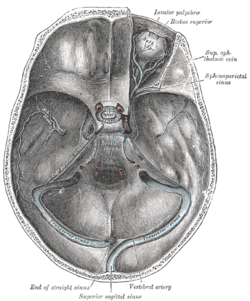| Superior ophthalmic vein | |
|---|---|
 Veins of orbit. (Superior ophthalmic labeled at top.) Veins of orbit. (Superior ophthalmic labeled at top.) | |
 The sinuses at the base of the skull. (Superior ophthalmic vein labeled at upper right.) The sinuses at the base of the skull. (Superior ophthalmic vein labeled at upper right.) | |
| Details | |
| Source | Union of angular vein and supraorbital vein |
| Drains to | Cavernous sinus |
| Artery | Ophthalmic artery |
| Identifiers | |
| Latin | vena ophthalmica superior |
| TA98 | A12.3.06.102 |
| TA2 | 4887 |
| FMA | 51246 |
| Anatomical terminology[edit on Wikidata] | |
The superior ophthalmic vein is a vein of the orbit that drains venous blood from structures of the upper orbit. It is formed by the union of the angular vein, and supraorbital vein. It passes backwards within the orbit alongside the ophthalmic artery, then exits the orbit through the superior orbital fissure to drain into the cavernous sinus.
The superior ophthalmic vein can be a path for the spread of infection from the danger triangle of the face to the cavernous sinus and the pterygoid plexus. It may also be affected by an arteriovenous fistula of the cavernous sinus.
Structure
The superior ophthalmic vein - together with the inferior ophthalmic vein - represents the principal drainage system of the orbit (with the superior ophthalmic vein being the larger of the two). The superior ophthalmic vein drains venous blood from structures of the upper orbit. The superior ophthalmic vein forms/represents a connection between facial veins, and intracranial veins. It is valveless.
The superior ophthalmic vein is the largest and the most consistently present vein of the orbit. It usually measures 2-10 mm in diameter.
Origin
The superior ophthalmic vein is formed (depending upon the source) either by the union of the angular vein, and supraorbital vein, or by the union of two tributaries which connect anteriorly with the supraobrital vein, and the facial vein.
Its origin is situated within the orbit, near the superomedial orbital rim, posteromedial to the upper eyelid.
Course and relations
The superior ophthalmic vein is the only orbital vein whose course generally parallels the course of an orbital artery: it has a similar course as the ophthalmic artery (however, the latter instead exits the orbit through the optic canal).
Within the orbit, the superior ophthalmic vein passes posterior-ward alongside the ophthalmic artery. It passes inferior to the superior rectus muscle, running in between this muscle and the optic nerve. It runs across the optic nerve (CN II) to reach the superior portion of the superior orbital fissure through which it then exits the orbit to drain into the cavernous sinus. It usually passes superior to the common tendinous ring on its way out of the orbit.
Tributaries
Tributaries of the superior ophthalmic vein (may) include: the anterior ethmoidal vein and posterior ethmoidal vein, lacrimal vein, central retinal vein (sometimes), superior vorticose veins, medial palpebral veins, inferior ophthalmic vein (sometimes), and veins from the superior rectus muscle, superior oblique muscle, and medial rectus muscle.
The tributaries/territory drained by the superior ophthalmic vein is however somewhat variable.
Structures drained by the superior ophthalmic vein includes the frontal sinus.
Fate
The superior ophthalmic vein drains into the cavernous sinus.
Clinical significance
Cavernous sinus thrombosis
The medial angle of the eye, nose and lips (known as the danger triangle of the face) usually drain through the facial vein, via the superior ophthalmic vein through the cavernous sinus. An infection of the face may spread to the cavernous sinus through the superior ophthalmic vein. This can cause cavernous sinus thrombosis. This can lead to damage of the nerves running through the cavernous sinus.
Arteriovenous fistula
When arteriovenous fistula affects the cavernous sinus, blood flow may occur backwards in the superior ophthalmic vein. This can cause exophthalmos. This may be treated by embolising the superior ophthalmic vein.
See also
References
- ^ Semmer, A. E.; McLoon, L. K.; Lee, M. S. (2010). "Orbital Vascular Anatomy". Encyclopedia of the Eye. Academic Press. pp. 241–251. doi:10.1016/B978-0-12-374203-2.00284-0. ISBN 978-0-12-374203-2.
- ^ Remington, Lee Ann (2012). "11 - Orbital Blood Supply". Clinical Anatomy and Physiology of the Visual System (3rd ed.). Butterworth-Heinemann. pp. 202–217. doi:10.1016/B978-1-4377-1926-0.10011-6. ISBN 978-1-4377-1926-0.
- ^ Standring, Susan (2020). Gray's Anatomy: The Anatomical Basis of Clinical Practice (42nd ed.). New York. p. 780. ISBN 978-0-7020-7707-4. OCLC 1201341621.
{{cite book}}: CS1 maint: location missing publisher (link) - Sinnatamby, Chummy S. (2011). Last's Anatomy (12th ed.). Elsevier Australia. p. 377. ISBN 978-0-7295-3752-0.
- Moini, Jahangir; Piran, Pirouz (2020). "5 - Blood supply of the CNS". Functional and Clinical Neuroanatomy - A Guide for Health Care Professionals. Academic Press. pp. 131–176. doi:10.1016/B978-0-12-817424-1.00005-7. ISBN 978-0-12-817424-1. S2CID 212816072.
- ^ Semmer, A. E.; McLoon, L. K.; Lee, M. S. (2010). "Orbital Vascular Anatomy". Encyclopedia of the Eye. Academic Press. pp. 241–251. doi:10.1016/B978-0-12-374203-2.00284-0. ISBN 978-0-12-374203-2.
- ^ Fielding, John A. (2011). "47 - The eye and orbit". Clinical Ultrasound. Vol. 2 (3rd ed.). Churchill Livingstone. pp. 938–964. doi:10.1016/B978-0-7020-3131-1.00047-X. ISBN 978-0-7020-3131-1.
- Ahmed, A.; Albuquerque, F. C. (2014). Encyclopedia of the Neurological Sciences - Reference Module in Neuroscience and Biobehavioral Psychology (2nd ed.). Academic Press. pp. 53–56. doi:10.1016/B978-0-12-385157-4.00746-6. ISBN 978-0-12-385158-1.
External links
- lesson3 at The Anatomy Lesson by Wesley Norman (Georgetown University) (orbit4)
- "Figure 47-5". Dartmouth.edu. Retrieved 2016-08-09.
| Veins of the head and neck | |||||||||||||||||||||||
|---|---|---|---|---|---|---|---|---|---|---|---|---|---|---|---|---|---|---|---|---|---|---|---|
| External jugular |
| ||||||||||||||||||||||
| Internal jugular |
| ||||||||||||||||||||||
| Brachiocephalic |
| ||||||||||||||||||||||